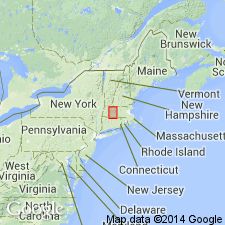
- Usage in publication:
-
- Standing Pond Volcanics*
- Modifications:
-
- Areal extent
- AAPG geologic province:
-
- New England province
Summary:
Provisionally restricted from MA in favor of the name Putney Volcanics. In northern MA, these rocks were first mapped by Balk (1956) as occurring within his Leyden Argillite [approx the same as present-day Littleton Formation]. Doll and others (1961), in adjacent southern VT, included these rocks in Standing Pond Volcanic Member of Waits River Formation on their Centennial Geologic Map of Vermont, despite that they showed the rocks, as do Zen and others (1983) on the MA State geologic map, at the Gile Mountain-Littleton formational contact, totally isolated from Waits River Formation. Trask (1964) applied the name Standing Pond Volcanics to these rocks in northern MA and southern VT, treating them as a discrete formation. Hepburn (1972), in remapping southeasternmost VT, called the rocks Putney Volcanics in order to distinguish them from other parts of the Standing Pond. Trask (1980) then extended the name Putney into northern MA, and pointed out that Putney Volcanics are not physically traceable into Standing Pond Volcanics. Furthermore, amphibolites in Gile Mountain and Waits River Formations probably correlate with the Standing Pond as they are more mafic in composition. Standing Pond and correlatives in VT and MA are everywhere at or near Waits River-Gile Mountain contact; Putney Volcanics are at or near Gile Mountain-Littleton contact. Further mapping needed to establish continuity between Putney and Standing Pond. [Papers presented as chapters in U.S. Geological Survey Professional Paper 1366 are intended as explanations and (or) revisions to MA State bedrock geologic map of Zen and others (1983) at scale of 1:250,000.]
Source: GNU records (USGS DDS-6; Reston GNULEX).
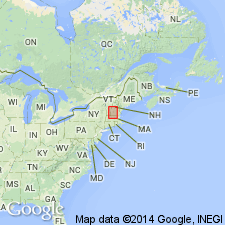
- Usage in publication:
-
- Standing Pond Volcanics
- Modifications:
-
- Geochronologic dating
- AAPG geologic province:
-
- New England province
Summary:
Isochron cooling age of 440+/-10 Ma determined for Standing Pond Volcanics. U-Pb of 423 Ma found for felsic dike that cuts Standing Pond near Springfield, VT. Data presented support occurrence of amphibolite facies metamorphic event in eastern VT and central MA during the Ordovician. All rocks of the CT Valley synclinorium (Gile Mountain, Waits River, and underlying strata) were subjected to this same event.
Source: GNU records (USGS DDS-6; Reston GNULEX).
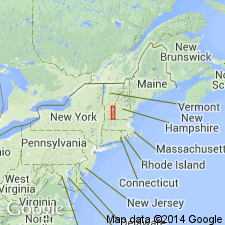
- Usage in publication:
-
- Standing Pond Volcanics*
- Modifications:
-
- Age modified
- Geochronologic dating
- AAPG geologic province:
-
- New England province
Summary:
Used as Standing Pond Volcanics in VT following usage of Hepburn and others, 1984). New U-Pb zircon data indicate an age of 423 +/-4 Ma (Silurian) (or 421 +/-2 Ma using weighted average of Pb-Pb ages) for a dike cutting Standing Pond Volcanics. This in turn implies that the Waits River Formation-Gile Mountain Formation sequence is at least Middle Silurian or older, not latest Silurian to Early Devonian as was previously thought.
Source: GNU records (USGS DDS-6; Reston GNULEX).
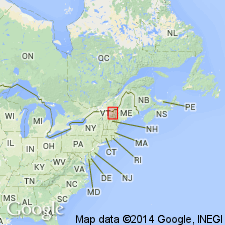
- Usage in publication:
-
- Standing Pond Volcanic Member*
- Modifications:
-
- Geochronologic dating
- AAPG geologic province:
-
- New England province
Summary:
Lead isotope age of 423+/-4 Ma on cross-cutting dike in Standing Pond Volcanic Member provides minimum Silurian age for Waits River Formation. Presence of plant fossils in northern NH and southern Quebec supports a late Early Devonian (Emsian) age for the overlying Gile Mountain Formation and its equivalent, the Compton Formation. Gile Mountain includes the Meetinghouse Slate Member and the newly assigned Northfield Member, here considered a distal western facies of the Gile Mountain equivalent to the Meetinghouse. Authors conclude that the rocks of the Connecticut Valley trough accumulated continuously beginning as early as the Silurian and extending into the latest Early Devonian.
Source: GNU records (USGS DDS-6; Reston GNULEX).
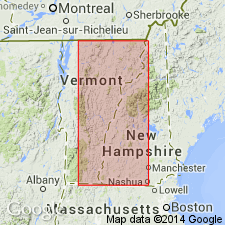
- Usage in publication:
-
- Standing Pond Volcanic Member*
- Modifications:
-
- Revised
- Age modified
- AAPG geologic province:
-
- New England province
Summary:
Structural studies in northeastern and east-central VT show that the belt long known as the Connecticut Valley synclinorium is a faulted anticline, and it is here renamed the Connecticut Valley trough. The Waits River Formation underlies the Gile Mountain Formation. The Northfield Formation and Meetinghouse Slate Member of the Gile Mountain Formation were interpreted as resting depositionally on older rocks to the west and east. The Northfield is revised as the Northfield Member of the Gile Mountain Formation, at the top of the Gile Mountain, rather than a separate formation below the Gile Mountain-Waits River package. The Meetinghouse Slate (Member of the Gile Mountain Formation of Doll and others (1961)) is revised as the Meetinghouse Slate Member of the Gile Mountain Formation, but at the top rather than at the bottom of the formation. The Standing Pond Volcanics (Standing Pond Volcanic Member of the Waits River Formation of Doll and others (1961)) is retained as the Standing Pond Volcanic Member of the Waits River. The age of all trough rocks is modified to Early Devonian.
Source: GNU records (USGS DDS-6; Reston GNULEX).
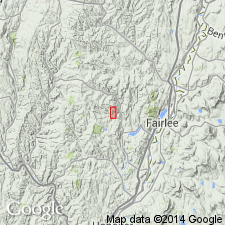
- Usage in publication:
-
- Standing Pond Volcanic Member*
- Modifications:
-
- Age modified
- AAPG geologic province:
-
- New England province
Summary:
Authors disagree with Hatch (1991) regarding age of Gile Mountain Formation, Waits River Formation, and Standing Pond Volcanic Member of Waits River Formation. The Standing Pond Volcanic Member occurs mostly along mapped Gile Mountain-Waits River contact. 70 km south of Ely, VT, a felsic dike dated as Middle Silurian by Aleinikoff and Karabinos (1990) intrudes the Standing Pond; this effectively dates the Waits River Formation as no younger than Middle Silurian. The overlying Gile Mountain Formation is tentatively assigned a Middle Silurian(?) to Early Devonian age. The Early Devonian part of its age is based on plant fossils in equivalent rocks 100 km to the north in Quebec, as reported by Hueber and others (1990).
Source: GNU records (USGS DDS-6; Reston GNULEX).
- Usage in publication:
-
- Standing Pond Volcanics
- Modifications:
-
- Age modified
- Geochronologic dating
- AAPG geologic province:
-
- New England province
GNU Staff, 1995, GNU Staff remark by E.D. Koozmin. Standing Pond Volcanics and Gile Mountain Formation in Vermont.: U.S. Geological Survey Digital Data Series, DDS-6, 1 CD-ROM., release 3
Summary:
According to Robert Moench (1993, written commun.) age of Standing Pond Volcanics should be Silurian. Hatch (1991) apparently did not acknowledge U-Pb zircon date of 423+/-4 Ma (Aleinikoff and Karabinos, 1990) from a dike that cuts Standing Pond Volcanics, which therefore must be Silurian (Wenlockian or Llandoverian). It is very likely that unconformably overlying Gile Mountain Formation is also Silurian. Moreover, latest version of Sherbrooke-Lewiston quad shows Gile Mountain Formation (with sparse nondiagnostic fossils) and Compton Formation (with diagnostic Emsian fossils) are not coextensive across international border. Moench suggests retaining Early Devonian age for Gile Mountain Formation, but with a query to flag the problem. Moench also suggests a Silurian age for Waits River Formation as shown in figure 2 of Hatch (1991).
Source: GNU records (USGS DDS-6; Reston GNULEX).
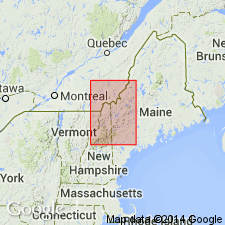
- Usage in publication:
-
- Standing Pond Volcanics*
- Modifications:
-
- Overview
- AAPG geologic province:
-
- New England province
Summary:
Standing Pond Volcanics of southeastern VT is tentatively considered equivalent to unnamed volcanic and sedimentary member of Waits River Formation of thesis map area.
Source: GNU records (USGS DDS-6; Reston GNULEX).
For more information, please contact Nancy Stamm, Geologic Names Committee Secretary.
Asterisk (*) indicates published by U.S. Geological Survey authors.
"No current usage" (†) implies that a name has been abandoned or has fallen into disuse. Former usage and, if known, replacement name given in parentheses ( ).
Slash (/) indicates name conflicts with nomenclatural guidelines (CSN, 1933; ACSN, 1961, 1970; NACSN, 1983, 2005, 2021). May be explained within brackets ([ ]).

